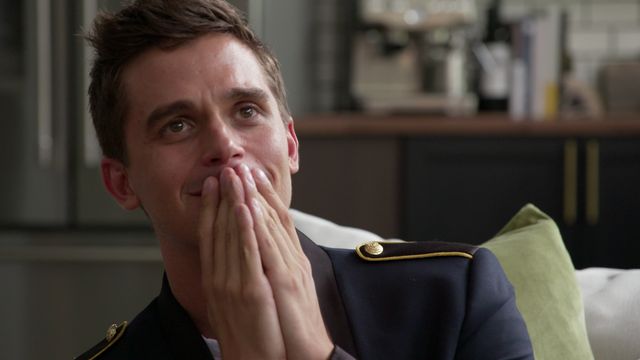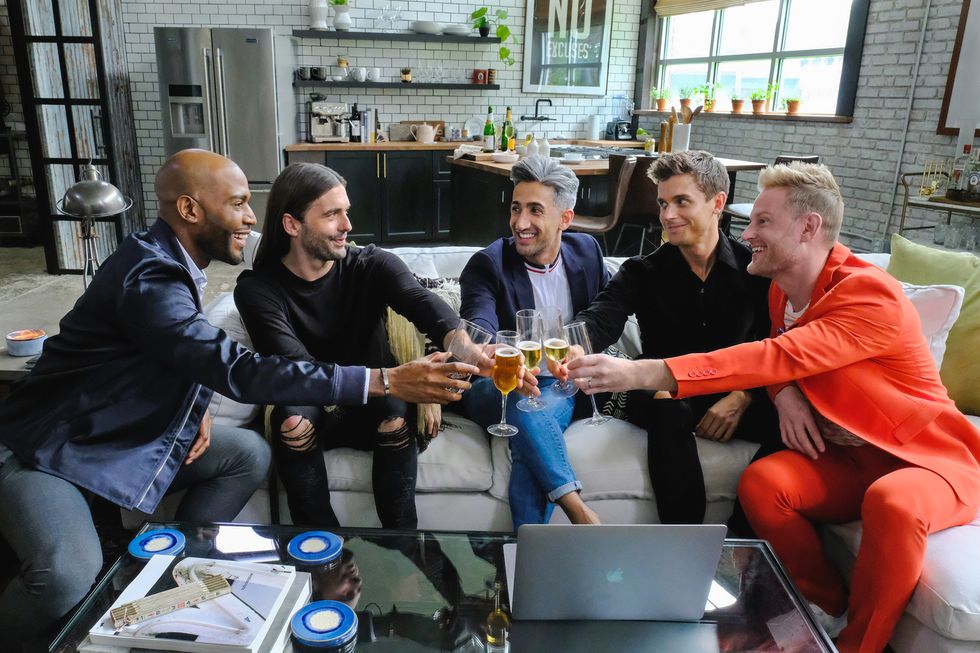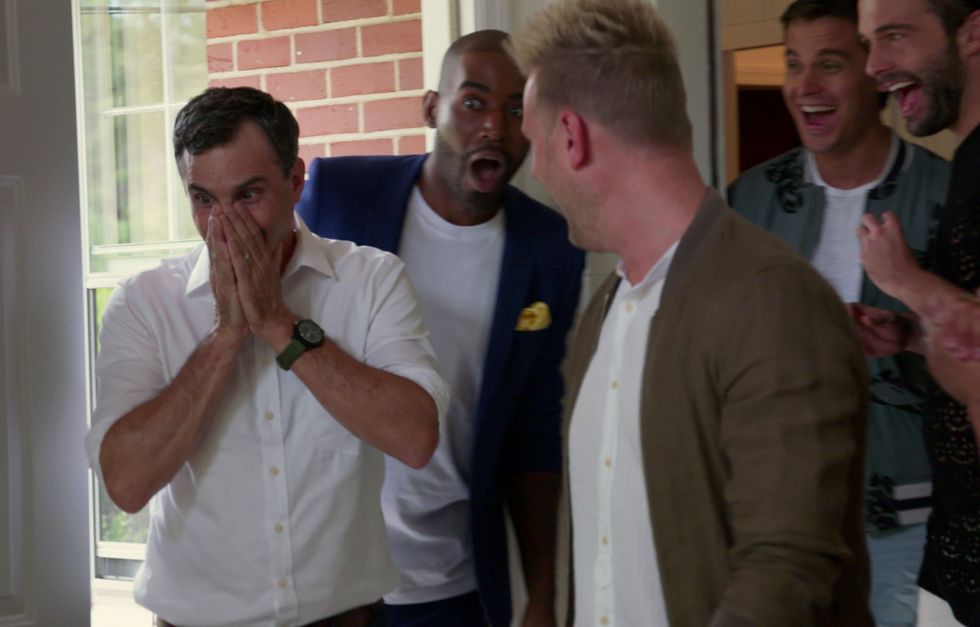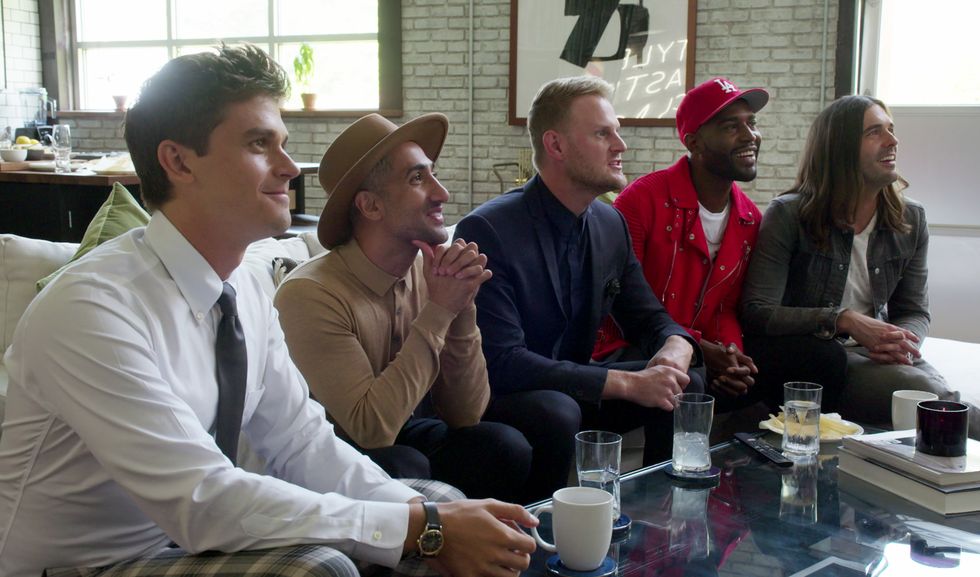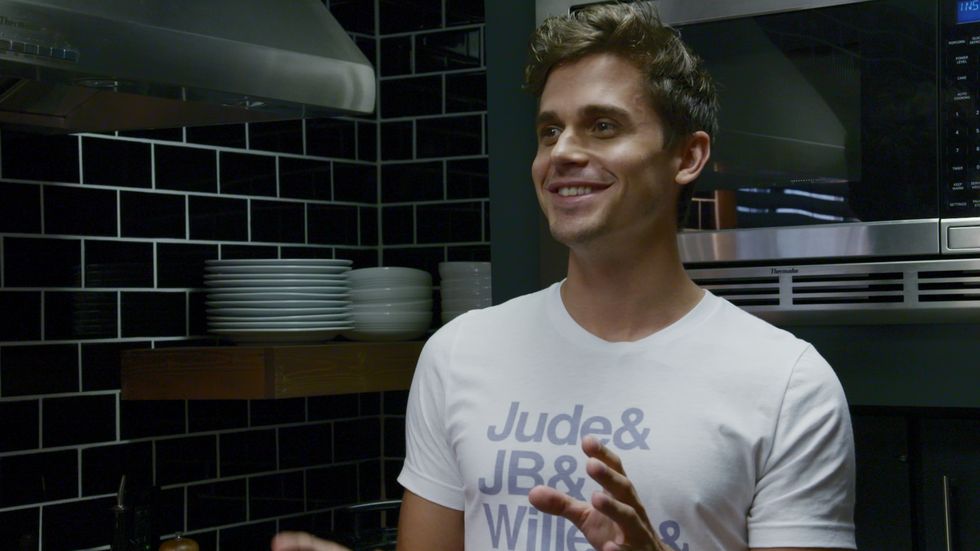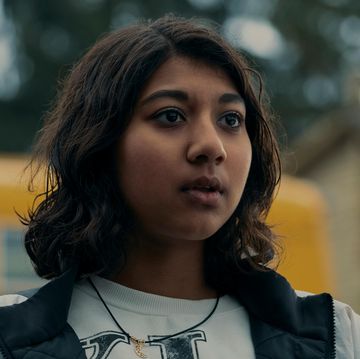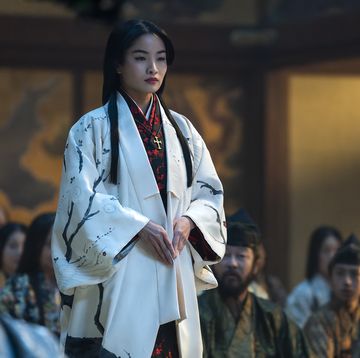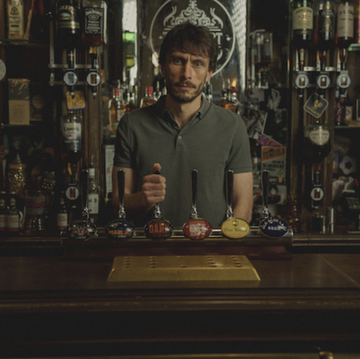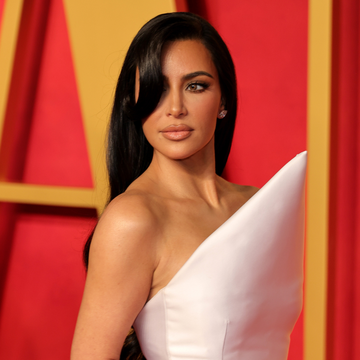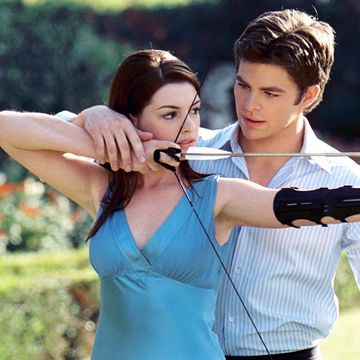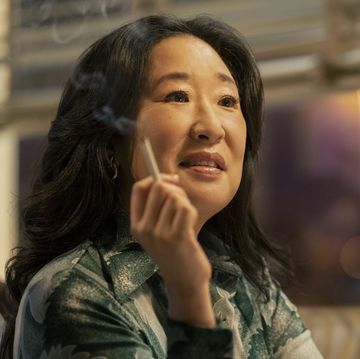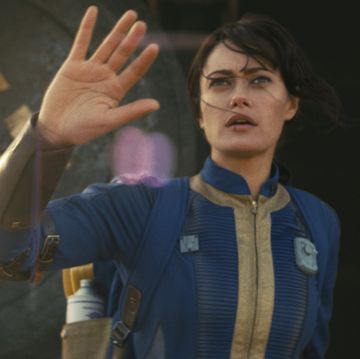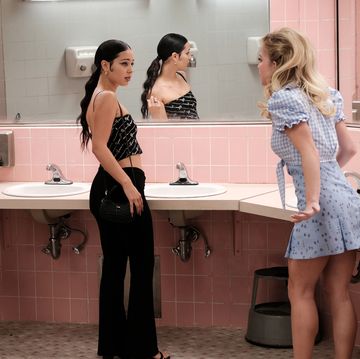Midway through the second episode of Queer Eye, Netflix's reboot of the DADT-era makeover show, I mused aloud "I wonder how many of these guys have read The Velvet Rage." It was a passing notion; I was honestly curious if any of the Fab Five—cisgender gay men; three white, one black man, and a British-American of Pakistani descent—had read psychologist Dr. Alan Downs' seminal work on queer identity, gay shame, and self-acceptance. It was just a thought. But even as I said it, I clocked something inside of the question that smelled a little bit like shade. Was I judging these people? Why was I judging these people?
Perhaps we were just running on different wavelengths. All of the people onscreen were giving me Queer Exuberant—think the way Sasha Velour shakes rose petals from her wig or Nathan Lane says "I've pierced the toast" in The Birdcage. And I was, at that moment, feeling very Queer Sedate, merging with Queer Arch. Almost at Queer Over It. My mood could best be expressed by Beth Leavel drawling "Antarctica? Oh please," in The Drowsy Chaperone mixed with a supercut of that line from every high school production of the same play.
That's a very Queer Indulgent way of saying I was tired. Or should I say Queer Tired.
So, I wasn't necessarily in the best space to receive what is ultimately a light confection that occasionally chips away at the rock face of toxic masculinity. Whereas the Original Fab Five were on a mission to prove their worth through usefulness, this new batch are here to reaffirm their own worth. And your worth. And also redecorate your home.
I knew this much going in: Everyone said they cried watching it and everyone has very divisive opinions about Antoni, the food expert whose t-shirts un-ironically reference A Little Life, Hanya Yanagihara's absolutely devastating seminal work in the genre of Queer Misery.
We'll get to Queer Crying in just a second. But first, for the record, I have absolutely zero qualms with the sophistication of Antoni's cooking. The whole idea is to give these dudes accessible recipes that they'll actually make. I identify as "Queer, Very" and "Medium Extra" and even I am sometimes undone by a Blue Apron meal. "Everything is already portioned for you; what's wrong with you?" I say to the mirror, channelling Annette Bening in American Beauty. (Second only to Harper Pitt in Queer-Adjacent Regenerative Rage Icons.) Y'all need to lay off of Antoni. If it's so easy to make good guacamole why are y'all out here at the Chipotle paying extra for it? Skittle me that, haters.
Anyway, the crying. You're supposed to cry at makeover shows; that's how it works. And you're supposed to cry when you're on reality TV. You cry when you don't get a rose on The Bachelor, you cry when they move that bus on Extreme Makeover: Home Edition. The dream is realized or it is crushed and you cry. And we cry. And Andy Cohen is appeased and grants humanity another day.
But I didn't cry.
The show hinges on a kind of magic made possible by Queer Performance. There are many different ways of being queer—something I desperately wish the show was more invested in. Must everyone be cisgender and cis-presenting? Must everyone be Fab? Must everyone fall within a particular size range? But at a basic level, queerness engages with a duality: there is Queer Exuberance and there is Queer Concealment. Our history is at once one of flash and one of code. This is a self-protective gesture as well as a bit of cultural myth-making. So, the premise of Fabulousness, which is the calling card that the five men present as they march through the door with the confident strut of Barbra Streisand as Fanny Brice heading for the ferry, is a sleight of hand maneuver. They go big so that the makeover subjects can start to investigate themselves on a smaller scale. Call it, perhaps, Queer Magic.
Queer Eye is, more than anything, a docu-series about Queer Emotional Labor. The Fab Five approach these men who are, in some way, not living fully realized lives because of deep seated pain and they offer to acknowledge it. Downs, in The Velvet Rage, writes "Authentic validation inoculates us from the ravages of shame. If we are receiving adequate amounts of authentic validation, then shameful comments or feelings simply have little impact on us."
This, I believe, is the project of the show. But Downs is talking about queer lives. And that, as I finished the third episode, was the thing sitting between me and fully embracing the show. I wasn't interested in seeing Queer Magic worked on Straight Pain.
I have a play running in Chicago right now, Time Is On Our Side, which is, essentially, about Queer Magic. It's a comedy with a mystery at its core that engages with Queer Duality and the possibilities for transformation that queerness allows. It exists in a place where queerness is a norm, which is to say it exists in the real world but it's not engaged with the straight gaze. Just before I started watching Queer Eye, I'd been on a phone interview about the play. The interviewer asked me whether I'd set out to be subversive in writing the play. It was a good question. I thought about it and then replied. "I wrote a play in which I saw myself. If being visible is subversive, then yes, I set out to be subversive."
So the question (Queerstion?) I asked the series as I watched was: Is the presence of five gay men on screen subversive, or were their presence and their fabulousness and their vulnerability simply in service of straight transformation?
This was important to figure out, since whatever fabulousness the five have clearly was hard-won. They, in interstitials, give elevator pitches about various moments in their histories: challenges they overcame, oppression they faced. They remind Cory, the Trump supporter, that the president's views are a threat to their rights, but stop short of doing anything as subversive or effective as what Adam Rippon did when faced with the prospect of meeting the vice president. Their struggles are not the project of the show. But they are the engine on which the show runs.
Downs writes, after name-checking the original Queer Eye for the Straight Guy, "Something about growing up gay forced us to learn how to hide ugly realities behind a finely crafted facade... The naked truth about who we are wasn't acceptable, so we learned to hide behind a beautiful image. We learned to split ourselves in parts, hiding what wasn't acceptable and flaunting what was."
For many queer people, the merging of the two parts, like the warring sides Hedwig sings about in "Origin of Love," is the work of a lifetime. Which is why it was so gratifying, and so cathartic, to see that work put in service of a queer, black person in the fourth episode.
We meet AJ, a civil engineer who has a black boyfriend, queer friends, and a messy house. AJ is fine. Like, doing okay and also FINE. But AJ isn't out to his stepmother and did not get to come out to his father before his father died, so there is turmoil. Plus, AJ's Queer Duality is written in neon letters across his whole life.
"I am one person at work; I am another person at home. I'm completely different around my family," AJ says. This is a dude with a leather harness in his closet and a seemingly vibrant social life, who is still blocked off from the fullness of his life.
Enter Queer Magic, like beans stolen from a neighbor's garden.
Fashion expert Tan, Antoni, and AJ have a fascinating conversation about presentation and determining how much Queer Peacocking (my term, obviously) is comfortable, acknowledging nuance and variation in the queer community. Lifestyle expert Karamo engages with AJ's fears on an obstacle course and then demonstrates peer mentorship between gay black men. Beauty pro Jonathan, ever a delight, takes him to a black barber and is like, "Y'all know what to do."
And, just as with the straight men, AJ is gradually able to chip away at the barrier between his surface presentation and the river of complex pain that flows beneath. But something astounding clicks into place when the community is able to heal itself.
At the end of his episode, AJ throws a party for his friends and invites his stepmother. He steps into his bedroom with her and pulls out a letter he's composed to his deceased father. In the letter he comes out almost as an afterthought. Indeed, he treats it in the text like something that his father would already know because his father knows his son. That is Queer Magic. It seems to say, You see all of me because I am here and I don't have to create any facades to make myself visible for you.
When AJ reads the words, "I am gay," and AJ's stepmom smiles at him, widely, openly, calmly, I lost it. She sees him and grins at him. That is extraordinary. That is magical. That is subversion with no words.
The two collapse on each other in a mix of shared grief, shared relief, and the shared joy of knowing another person, truly. I Queer Sobbed.
What's most striking to me about the series is not so much the subversion of toxic masculinity, but rather the frank acknowledgment of ever-present pain even in moments of joy. Emotionally, the show is the equivalent of chipper, conservatively dressed Antoni sporting his A Little Life tees without comment.
At its best, Queer Eye is able to simply hold an individual's wholeness. And sometimes grin at it. That's so rare. Onscreen, queer pain, like black pain, is often a device used to unlock something in another whose identity shields them from that pain. It's the "You is Kind, You is Smart, You is Important" technique.
AJ weeps. It's almost too much; it's almost overwhelming. There is a dam bursting and it feels intrusive to watch. This, to me, is the Queer Truth that is possible in this show.
"Behind the facade, we are honestly and without reservation human," Downs writes. "And it's past time for us to realize that living the ideal gay life isn't humane in the least."
Sometimes, to my mind, the project of queerness is a series of negotiations, using flourish and concealment and code and glittering obfuscation to determine how safe an environment is, not only for the Queer Body but for the Queer Pain. It is dropping references to see who picks them up as a way of taking a room's temperature. (I know you didn't know what I was talking about when I mentioned Beth Leavel, by the way.) Queer Eye is, undoubtedly, for straight eyes but it does give a fascinating glimpse at the magic and mechanics of the performance of a kind of queerness, the simple yet subversive act of learning to be present for one's own joy and pain.
